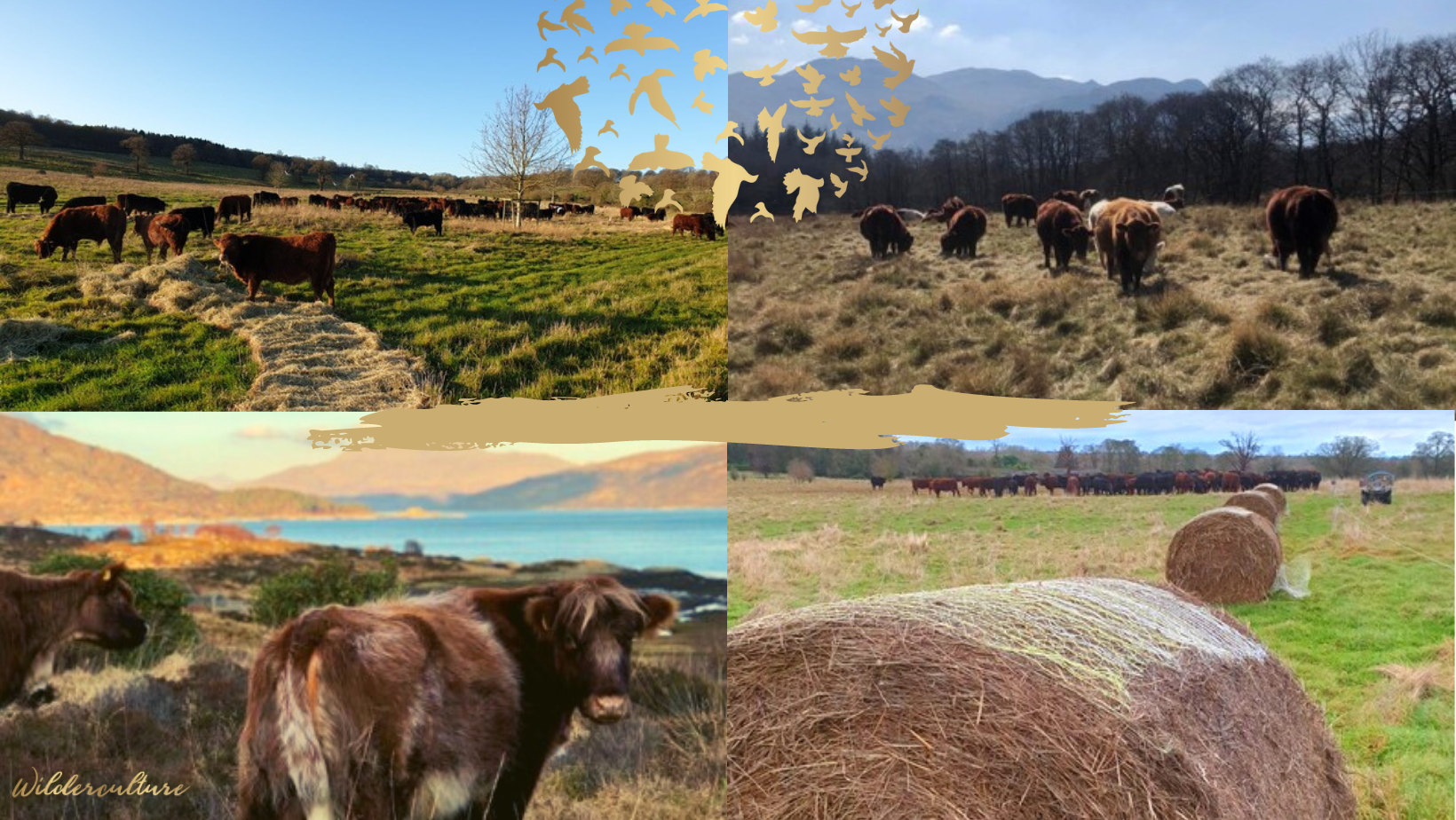
Outwintering cattle is revolutionising farming in the Uplands.
Outwintering cattle is revolutionising farming in the Uplands.
By Georgia Wingfield-Hayes
“Until very recently, I thought outwintering without hay was a fantasy in our climate and conditions – Now, I’m pretty much completely convinced that we could do it in all but the worst snow conditions – it’s amazingly simple and easy. Why was this so hard in my head?”
James Rebanks, Matterdale, Cumbria
Like James, when I first heard talk of outwintering, it sounded like a great idea that probably wouldn’t work. So it’s been exciting to catch up with various farmers in different parts of the country and hear how outwintering is revolutionising farm life.
Outwintering takes different forms depending on what outcomes you are looking to achieve. On FAI’s farm Wytham, in Oxfordshire for example, they have seen many changes over the past five years since they first trained with Caroline and adopted a regenerative approach to their livestock operations. Now regenerative beef production is the aim, so outwintering is done with precise calculations and the addition of big bales of hay previously set out in paddocks. At the other end of the spectrum, we have the Isle of Carna, a Wilderculture project where nine Whitebred Shorthorn x Highland cattle, happily living all year round with no supplementary feed. The aim being to help rewild the island to a wood-pasture type habitat.
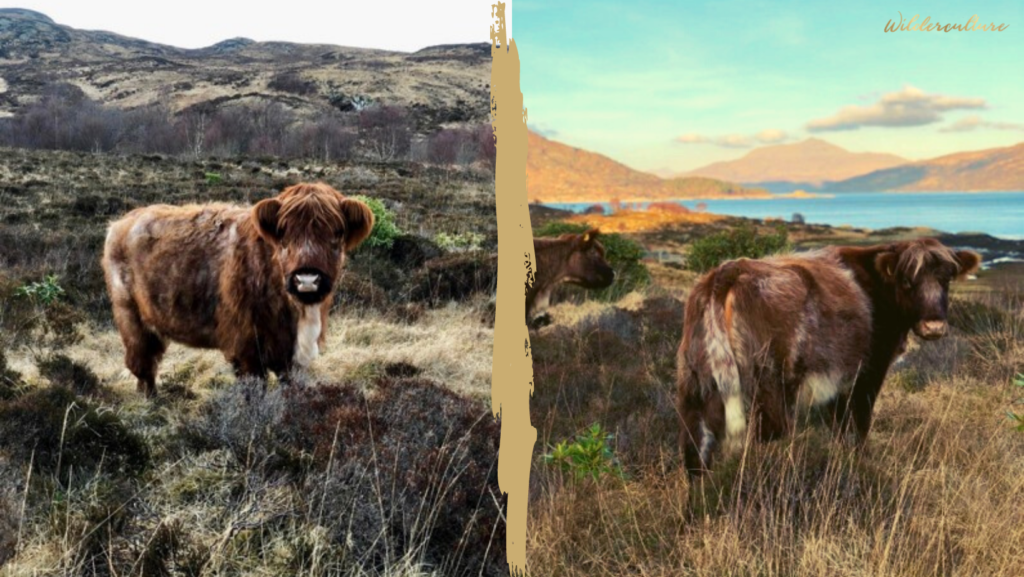
Whitebred Shorthorn x Highland cattle on the Isle of Carna.
On James Rebanks’ farm in Matterdale, in the Lake District, on the other hand, we have something between the two. He outwinters 10 Belted Galloway cows with followers on just 27 acres. He started preparing these fields in March in order to build the plant roots, thatch and older material. Then the area had one brief graze/trample for three days in August; the cattle went in on December 12th.
James moves them two, sometimes three times a day, which saves a fortune in hay. “These cattle can eat a £30 hay bale in a day… and a seven acre field has carried them for 30 days – no building, no tractor, no haulage, no muck spreader, no fertiliser, no muck handling, no straw, no bought feed, no medicines, and soil and grass that is in amazing health – all they get is one small hay bale worth £3 a day.”
“I’ll never keep cattle in a shed again as long as I live… I love this system.”
James Rebanks, Matterdale, Cumbria
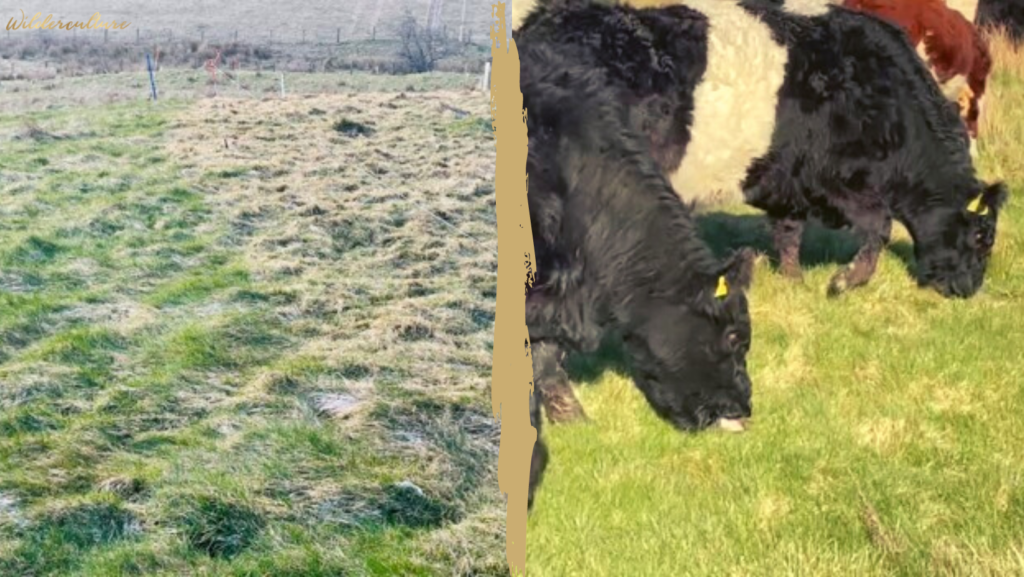
Belted Galloway cattle on James Rebanks’ farm in Matterdale.
The How and Early Mistakes
I spoke to James Rebanks, Silas Hedley-Lawrence manager of FAI’s farm Wytham, in Oxfordshire and Sam Beaumont at Gowbarrow Hall Farm, in the Lake District, about their experience of outwintering. They have all been on a steep learning curve. It seems the mistake commonly made in the first year is to run out of fodder too soon. This means you have to use the spring grazing early and hammer it too hard, which can set the whole year awry.
At Gowbarrow the approach to wintering is more akin to rewilding, where the cattle are able to roam freely along with four ponies and four pigs in a large area of upland wood pasture. The farm is managed in two blocks; the summer block and the 100-hectare ‘park’ which is the winter block.
Sam at Gowbarrow told me, “Last year we got to March, and I got carried away with grazing, getting the cows out of The Park and into the paddocks. I went through the spring grass way too quickly, so I had to put them back in The Park for a time.”
Regenerative planned grazing is used in the summer block between April and December, which is made possible by not needing to make much hay or silage on this meadowland. This management allows the winter block to fully rest and recover during the growing season, building a reserve of winter feed for the cattle when they go onto The Park in November/December time.
This winter Sam has done things a little differently. The Park was not grazed at all after April last year until the cows went on again in December. He set out just 20 round bales in an area of The Park that has some fencing, so access can be controlled. This supplementary feed is an insurance policy to buy time in March and April when fodder can run short and be of poor quality. Otherwise his 46 cows have lived the whole winter on The Park’s stockpiled grass, and they look very well on it too.
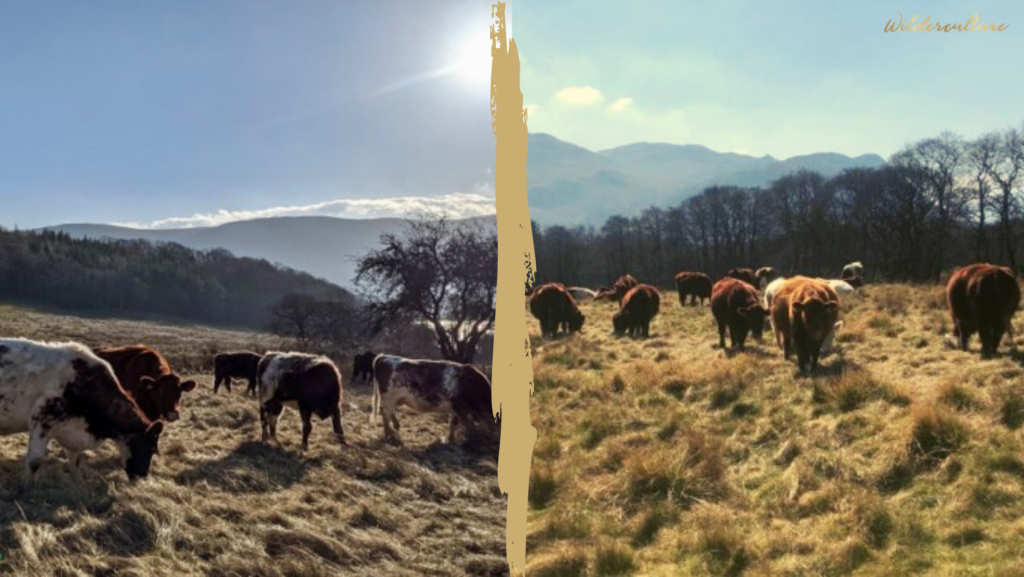
Cattle on stockpiled grass at Gowbarrow Hall Farm
An Economic No Brainer
One of the most compelling aspects of outwintering is how it changes the nature and economics of farming entirely.
“My time was taken up driving a tractor which is very isolating; it’s not good for a farmer. You don’t interact with the animals either.”
Sam Beaumont, Gowbarrow Hall Farm, Ullswater, Cumbria.
When Sam and his wife Claire took over Gowbarrow four years ago they were doing things very differently. “We were spreading fertiliser three times a year. The cattle were fed hay from September and housed from November. I was mucking out twice a day, feeding hay two times a day, then the muck spreader needed emptying every third day…”
Since undertaking a Wilderculture course and adopting a Wilderculture approach to their farming enterprise, winter is now a peaceful time at Gowbarrow. Sam generally goes up to the herd each day on foot. “It’s much more mindful walking, than being on a machine. You can observe the animals and how they behave. To them, the quad bike means something, ‘we’re being moved’ or ‘being fed,’ but on foot, you can walk right up to them and give them a scratch.”
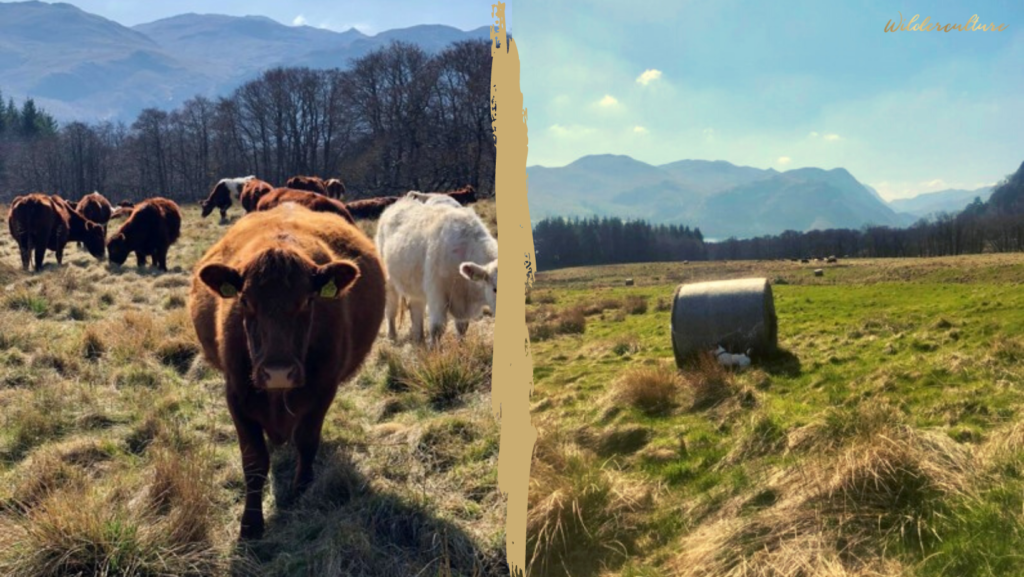
The cows and views at Gowbarrow Hall Farm in Ullswater – Lake District
Silas Hedley-Lawrence, manager of FAI’s farm Wytham, described how in July he made detailed mathematical calculations on just how much feed the herd would need to get through to spring. The suckler herd at Wytham, around 90 cows and heifers and 65 calves at foot, spend the winter on an area of land also known as ’The Park.’ 76.5 hectares of permanent pasture. An area that after being briefly grazed in July, is closed off to stockpile grass.
The area is divided into 161 cells of around 0.4 ha each, with 4 round bales in each cell, which were placed there in the summer. The herd is moved onto a new cell every day, and the bales are rolled out.
“The hay doesn’t just feed to cows; we want some left on the ground to be trampled in, to build soil carbon,” Silas told me. “In terms of improvement in soil health, fertility and biodiversity, The Park is performing perhaps better than anywhere else on the farm.” He goes on to explain that this is because this land gets the most consistent and effective use of the regenerative tools of animal impact, grazing and rest. “The cows can’t return to where they have grazed, so we get just the right amount of trampling, pushing the dry material into the ground and creating some bare soil,” continued Silas.
The hay used for bale grazing on The Park comes from the farm’s SSSI meadow by the River Thames. It is full of the seed from the 130 different species of plants found there. However, Silas believes that the incredible burgeoning of diversity in The Park might also come from a latent seed bank in the soil. “Other fields, even those that had a lot of moss and poor grasses, are now full of wildflowers: pyramid orchids, oxeye daisies, red and white clovers… everywhere is a sea of colour,” he enthuses.
The whole system at Wytham is now far more resilient and healthy, as are the cows. Their fertility runs at 95-98% and they have no calf mortality. Sam echoes much of what Silas says. At Gowbarrow they also have no problems with infertility or calving and all the cows are back in calf again.
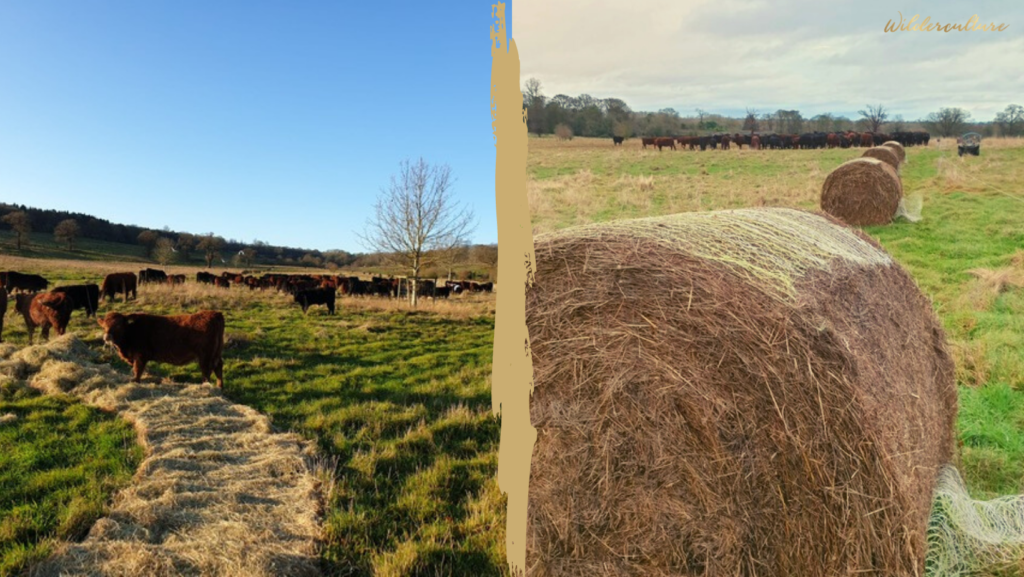
Cattle at FAI’s Wytham Farm enjoying their hay from the farm’s SSSI meadow.
Outwintering, it seems, is key in regenerative farming with livestock in order that we no longer have to depend on expensive artificial fertilisers, bought in feeds, machinery and fuels. It frees up time for other things, improves the quality of life for humans and animals alike and fosters a place for nature, as biodiversity returns to our farming landscape.
If you want to learn more about how outwintering could be a great addition to your grazing system then there are several ways to learn more.
- Outwintering: An out and out success. An open day at FAI farms Wytham where you can meet Silas, Caroline and the whole team to learn about all of the potential benefits and challenges of adopting an outwintering system on your farm.
- Grazing School – learn all about building a regenerative grazing plan from Caroline and James, held twice a year on James and Helen’s farm in the Lake District.
- Wilderculture basic training. Learn from Sam and Caroline through a combination of self-led online learning and a visit to Wilder Gowbarrow. Several dates throughout the year.
1 Comment


Joseph Alan Charlton 3 years ago
Alan writes, “….it is wonderful remembering my 40 months of living high up on those ecologically poor fells of NW Cumbria and observing the sadly ‘failed/failing systems of land management with four-footed mammals’ so this account is really uplifting…. thank you Georgia for doing the work to make it both readable and shareable…. looking forward to your next article ….